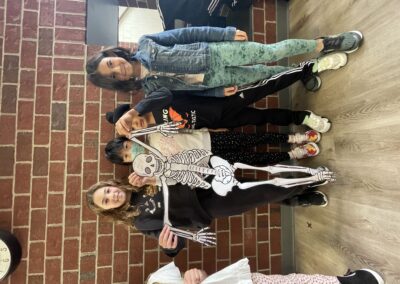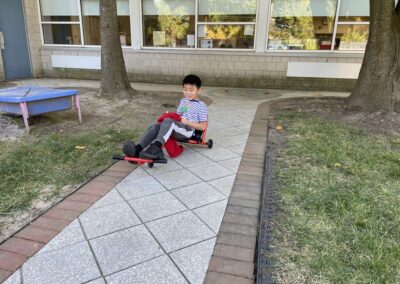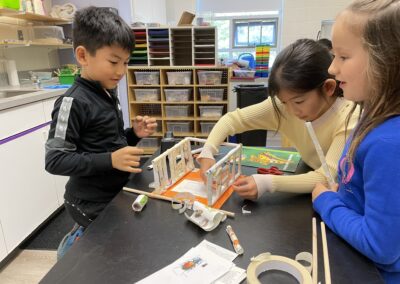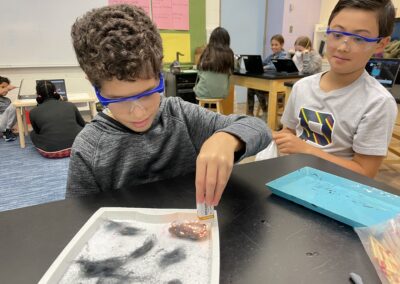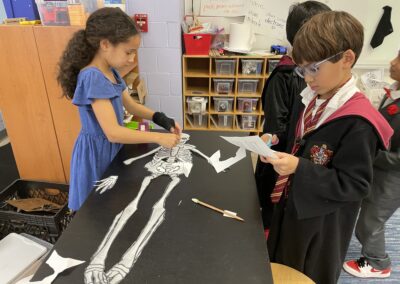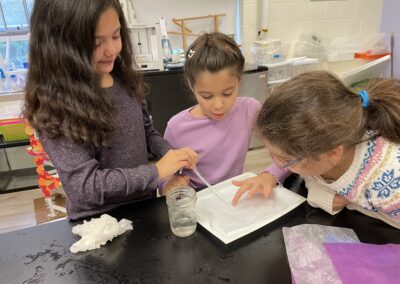For the Lower School science classes, one of the goals is to introduce the beauty and mystery of every aspect of different science disciplines to students and support them in seeing connections between those disciplines. This includes chemistry, physics, biology, earth science, astronomy, computer science, and engineering. It is our hope that students are equipped with the cognitive tools and scientific thinking to continue to learn independently in the future. The question is how we can support students to see the connections among those science disciplines? What is scientific thinking?
In 2011, the Framework for K- 12 Science Education, proposed an answer to those questions. The Framework presented a clear list of seven crosscutting concepts that scientists across all disciplines have been using, which include patterns; cause and effect; scale, proportion, and quantity; systems and system models; energy and matter; structure and function; and stability and change.
In Lower School science classes, we ask students questions when they make observations of different science phenomena, just like putting different pairs of “crosscutting glasses” in front of them to train students to see the world around them and think as scientists. Also, even though it’s impossible for students to review the same science knowledge every day, students are practicing using the same crosscutting concepts tools to build and reinforce their scientific thinking over years. In the following paragraphs, we will share examples of how students practice using the “pattern” as a tool with other crosscutting tools across all grades. Scientists make observations and identify patterns in nature, which guide organization and classification, prompt questions about relationships, and discover causes and effects.




Second graders were challenged to design a model of house in Antarctica. After they brainstormed possible issues they may encounter when building houses in Antarctica, they decided that their houses will need to be waterproof, hold weight, keep what’s inside warm and dry. After building the frame of the houses, students study the properties of different materials. In order to help them organize their ideas and make decisions, students were asked to use tables to identify the similarities and differences among different materials (pattern). After students conducted experiments to identify waterproof materials, we also took a look at the hydrophobic materials at the microscopic level (scale, proportion, and quantity) and discussed how we can use the microscopic structures to explain why the material is waterproof (cause and effect, structure and function).
Third graders learned about forces and motion. At the beginning of the unit, we discussed what a pattern is. Students use examples from math, games, and daily life to explain what a pattern is. We classified those examples as repeating patterns and changing patterns and discussed the importance of identifying patterns to discover the cause and effect relationships. During the study of forces, students were constantly challenged to describe their experiences and observations of forces and motion activities as “Everytime I do something, XXX happens.” for repeating patterns and “As I increase/ change XX, XXX also changes.” for changing patterns (stability and change).
Fourth graders will learn about energy throughout the year. At the beginning of the year, they were assigned to different stations to explore different forms of energy. At first, some students had difficulty identifying patterns of changes when energy flows into and out of the systems and documenting their observations in sentences (stability and change, system and system models, pattern). Students used the sentence prompts of changing patterns and repeating patterns to organize their thoughts and articulate ideas in written form.
Fifth graders learned about combustion first. Based on what we learned about energy last year, we discussed the energy flow during the chemical reactions. Now they are learning about the periodic table. After learning about the evolution of atomic structure, students used a simulation to construct No.1 – No.10 elements and identify the patterns of numbers of protons, neutrons and electrons for every stable neutral element. In following lessons, students will learn more properties of elements and practice arranging elements based on the properties.
In the science classes, students constantly use the same crosscutting concepts as tools to construct their understanding around different science topics. Hopefully, after years of practice, students can not only use those tools as an organizational schema for interrelating knowledge from various science fields into a coherent and scientifically based view of the world, but also generate new knowledge when they grow up.

